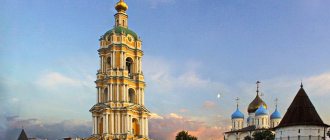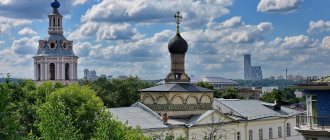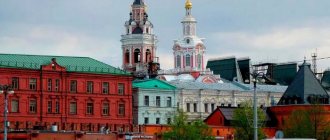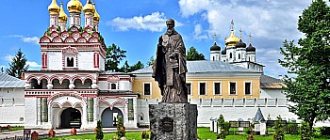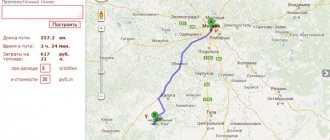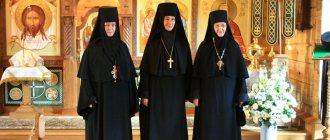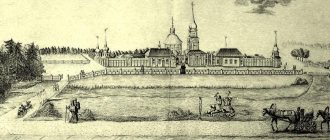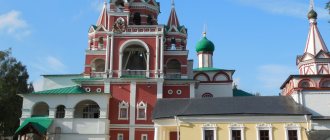We continue to explore our city. Unfortunately, we are not doing this very quickly. To my shame, it was only in the third year of living in Serpukhov that we finally made it to the Vysotsky Monastery. And in a good way, this was where we should begin exploring the city.
The Vysotsky Monastery in Serpukhov is considered one of the main attractions. But we always wanted to go somewhere far away, and therefore put off visiting him. They say that we will always have time to visit something that is close to home when it is difficult to get out somewhere. For this reason, it often turns out that what is close is never seen.
History of the monastery
The Vysotsky Monastery was founded by Prince Vladimir Andreevich the Brave, a cousin of Dmitry Donskoy. By the way, this prince was fluent in the Tatar and Lithuanian languages. And his cavalry also took part in the Battle of Kulikovo, where its attack from an ambush was decisive in the battle. To bless the foundation of the monastery, Vladimir the Brave invited Sergius of Radonezh, who came on foot to Serpukhov with his disciple Afanasy. Afanasy became the first abbot of the monastery. And this happened quite a long time ago, already in 1374.
The monastery was named “Vysotsky” because it was built above the Nara River on a hill called “Vysoky”. Previously, it was located about a kilometer from the city, but now, of course, the monastery is located within the city, because Serpukhov has grown greatly during this time.
By the way, for the construction of the monastery, white stone was used, which was taken from a local quarry. This place is now called the Zaborye quarry, it is unique and known throughout the world, but is gradually turning into a landfill.
Time passed, the Vysotsky Monastery was upset, its possessions expanded, and then the revolution broke out... and it completely stopped its work. But in the 90s it was reopened and restored.
Shrines
- Icon of the Mother of God “Inexhaustible Chalice”
- Icon of St. George the Victorious. 15th century
- Icon of the Mother of God “Seeking the Lost”
- Carved image of St. Nicholas “Nicholas of Mozhaisk” of the 14th century with picturesque stamps of the 17th century
- Icon of the Mother of God “Quick to Hear”
- Icon of the Mother of God “Joy of All Who Sorrow”
- Reliquaries containing more than 200 pieces of the holy relics of saints of God, glorified from the first centuries of Christianity to the present day: particles of the relics of St. right Anna - mother of the Blessed Virgin Mary, St. Forerunner and Baptist John; Apostles Andrew the First-Called, Luke, Matthew, Mark and Thomas; Equal to the Apostles Mary Magdalene, Tsar Constantine, Prince Vladimir; Saints Nicholas the Wonderworker, Basil the Great, Gregory the Theologian and John Chrysostom; Great Martyrs George, healer Panteleimon, Nikita, Barbara, Tatiana and Catherine; St. Sergius of Radonezh, Seraphim of Sarov, Ephraim the Syrian, about 50 particles of the relics of the Kiev-Pechersk saints of God; Optina Elders; New Martyrs of Russia: Patriarch Tikhon, Holy Martyr. Thaddeus of Tver, Hilarion of the Trinity, as well as many particles of the relics of other saints of God.
Inexhaustible Chalice
The monastery is famous for its miraculous icon “The Inexhaustible Chalice”. It is believed that it helps to get rid of illnesses, alcoholism, smoking, and drug addiction. Initially, the icon was in the Vladychny Convent, but was lost, probably burned along with other icons on the banks of the Nara during the hard times. In the 90s, two lists (copies) of this icon were written, one of which is now in the Vysotsky Monastery, and the second in the Vladychny Monastery. These two copies are equivalent, because icons have no copies at all, they all have equal power.
Current state
In 2002, the Great Consecration of the main church of the monastery, the Conception Cathedral, took place. On May 18, 2003, the monastery solemnly celebrated the 125th anniversary of the appearance of the miraculous image of the Mother of God “The Inexhaustible Chalice,” the veneration of which was resumed upon the opening of the monastery. The recreated prototype is located in the Intercession Church.
The monastery contains many shrines, reverently revered by believers, including about three hundred pieces of relics of the saints of God. A special place is occupied by the miraculous image of the Mother of God “The Inexhaustible Chalice”, into which is inserted a reliquary with a piece of the belt of the Blessed Virgin Mary. The image is glorified by many miracles and healings, mainly from the passions of wine drinking, drug addiction and smoking. In the same church rest the holy relics of St. Athanasius Vysotsky the Younger.
In the monastery, a full circle of divine services is performed daily with the obligatory water-blessing prayer at the end of the Liturgy before the miraculous image of the Mother of God “The Inexhaustible Chalice”.
Today the monastery has 10 inhabitants. The abbot of the monastery is His Eminence Roman, Bishop of Serpukhov. Divine services in the monastery take place on a full daily basis. Prayers are served daily before the miraculous image of the Mother of God “The Inexhaustible Chalice”. Many of the pilgrims who come to the monastery feel a special grace within the walls of the monastery: a prayerful mood, a desire for repentance and purification of the soul, peace in the “House of the Most Holy Theotokos.”
Impression
The Vysotsky Monastery is in excellent condition. It has been greatly restored and looks perfect. If the wall should be white, then it is ideally whitewashed; if the grille is black, then it is ideally painted black. There is impeccable order on the territory of the monastery. There weren't many people around during our visit. It’s nice to walk around here and think about something of your own, or sit in the temple and talk with God, even if you don’t believe in Him. True, I didn’t manage to think about something of my own: apparently, our little one was distracting.
Abbots
- St. Athanasius the Elder (1374 - 1382)
- St. Athanasius the Younger (1382 - 1395)
- Nikita (1395 - 1414)
- Andronik
- Alexander
- Savva
- Euthymius
- Joseph
- Pimen
- Joseph
- Theodosius
- And she
- Sergius
- Joseph
- Tarasiy
- Alippius
- Tarasiy
- Gennady
- Thaddeus
- Ignatius (1468)
- Markell
- Martyrium
- Lavrentiy
- Michael
- Or me
- Michael
- Vlasiy
- Gerasim
- Boris
- Gennady
- Spiridon
- Joseph
- Eusebius
- Dionysius
- And she
- Anthony
- Cyprian (1542)
- Paisius (1551)
- Agapit (1571)
- Joseph Chudovskoy (1576)
- Kirill
- Paisiy
- Theodosius (1601)
- Alexander
- Joseph (1614 - 1618)
- Joseph
- Jonah (1621)
- Anthony (1624 - 1632)
- Dionysius
- Job
- Leonidas (1652)
- Paphnutius (1657)
- Gerasim
- Zosimus (1660)
- Alexander (February 11, 1679 - 1681)
- Joseph (1686)
- Gerasim (1702 - 1737)
- Macarius (1737 - 1743)
- Joseph (Kornilov) (1743 - 1761)
- Innocent (1761 - 1778)
- Gennady (1778 - 1789)
- Stefan (1789 - 1792)
- Joseph (1792 - 1798)
- Ananias (1798 - 1802)
- Melchizedek (1802 - 1814)
- Neophyte (Dokuchaev-Platonov) (February 2 - August 12, 1814)
- Damascene (1815 - 1816)
- Hermogenes (1816 - 1817)
- Benjamin (1817 - 1818)
- Feoktist (1818 - 1820)
- Gabriel (1820 - 1821)
- Ambrose (1821 - 1827)
- Arseny (1827 - 1828)
- Ambrose (1828 - 1842)
- Melchizedek (1842 - 1850)
- Eustathius (1850 - 1851)
- Gideon (1851 - 1852)
- Sergius (1852 - 1861)
- Konstantin (1861 - 1870)
- Meletius I (1870 - 1879)
- Meletius II (1879 - 1881)
- Innocent (1881 - 1896)
- Tikhon (1896 -)
- Panteleimon (- 1928)
- Joseph (Balabanov) (February 28 - March 25, 1991) acting
- Kirill (Kostikov) (December 1998 - February 16, 1999) acting
Pilgrims
Pilgrims (men) can stay at the monastery for three days. For every day, a pilgrim must donate 280 rubles to the monastery, for which he can spend the night here, have lunch and dinner. If you want to stay longer, you must receive the blessing of the dean, after which you become a worker. The worker does not donate money, but is obliged to work in the monastery. The work is his donation to the monastery. Read more on the monastery website – www.visotskymonastir.ru
How to get there
The Family Suitcase company organizes pilgrimage trips.
Travel from Yoshkar-Ola
Travel from Cheboksary
Travel from Kazan
If you arrive by personal car, it is recommended to park in specially designated areas. If you do not follow this simple rule, there is a risk that your car will be taken by a tow truck. The parking area is small. On holidays it is quite lively here. Therefore, difficulties may arise as to where to park the vehicle.
An amazing place is located at the address: Moscow region, Serpukhov, st. Kaluzhskaya, 5/3. You can get to it by bus from Moscow, on an excursion tour or by train. From Serpukhovsky station to the monastery there are buses numbered No. 8, No. 3, No. 20. Monastery economy
Cafe
There is a cafe at the entrance to the monastery. Here you can drink coffee or tea and try monastic pastries. Very tasty and inexpensive.
Afanasy the Younger - a formidable old man on a horse
A small chapel adjoins the western wall of the Conception Cathedral of the Vysotsky Monastery. This is the tomb of the second abbot of the monastery, St. Athanasius the Younger. His coffin is decorated with a wooden image of a monk, who lies with his arms crossed on his chest. The vaults of the tomb are painted with scenes from the life of the saint. The central place is occupied by the fresco “Deliverance of the city of Serpukhov from the Hagarians by St. Athanasius.” On it, Saint Athanasius the Younger rides on a white horse and holds a staff in his hands. Enemies run away from the rider in fear, dropping their shields. “Hagharians” here refers to the Crimean Tatars, who, under the leadership of Devlet-Girey, approached the walls of Serpukhov in the 16th century.
The life of the saint tells that in 1571 “the Crimean evil-believers Tatars and with them Polish people” set up camp near the Vysotsky Monastery. Suddenly the enemies saw an old man riding out of the monastery on a white horse and galloping up the river to the church. In the Tatar camp they were surprised that this monk was not afraid to show himself, although the rest left the monastery and took refuge in the city fortress. The elder not only fearlessly entered the church, but went on horseback straight to the enemy camp, brandishing his staff. “The whole barbarian horde and the Polish host” were frightened by the terrible vision of a monk on a horse and ran, crushing each other. Seeing the confusion in the enemy camp, the defenders of Serpukhov came out of the city fortress and pursued the nomads. The elder was “swarthy, with great, black and thick hair.” Residents of the city and monks believed that it was Abbot Athanasius the Younger who came two hundred years after his death to save the monastery.
The first posthumous miracle of Athanasius the Younger occurred on the day of his funeral. The custodian of church things, who did his monastic work poorly, was angry with the saint and did not come to the burial. For this, the evil spirit began to “beat and torment mercilessly” the monk. Repenting of his act, the monk hurried to the burial of Athanasius and received healing from “demonic torment” at his tomb. When the saint's coffin was being laid in the grave, this monk suddenly fell into the ditch. Chernets was pulled out of the grave, and he said the following: Abbot Afanasy grabbed him by the hand and predicted his imminent death. Three days later, the custodian of church things died.
The life says that clergy and monks at different times noticed other unusual phenomena at the grave of Athanasius the Younger. Burning candles were found on the abbot's coffin. Sometimes they saw how candles from the altar themselves went to the saint’s tomb and disappeared there. Someone heard church singing at Athanasius’s grave. Others noticed the late abbot with a censer or candles, walking around the churchyard and the surrounding area of the monastery.
In 1697, a relative of Tsar Peter I, Melanya Timofeevna Naryshkina, donated money to build a small church over the grave of Athanasius the Younger. In 1878, the Naryshkin church was dismantled and a new spacious church of Sergius of Radonezh and Athanasius of Athos was built. This temple was demolished during the Soviet period, and the current chapel was erected over the grave in our time. In 1994, the relics of Athanasius the Younger were moved from the grave to the shrine and placed in the Church of the Intercession, where the famous “Inexhaustible Chalice” icon is located. However, the former grave is still revered by pilgrims. Something similar happened with the grave of the blessed Matrona of Moscow. In 1998, her relics were transferred to the Pokrovsky Monastery, but admirers of the saint still come to her grave at the Danilovsky cemetery.
Patronal holidays[edit]
Conception of the Blessed Virgin Mary by Righteous Anna
— December 22
Sergius of Radonezh, Venerable
— Cathedral of Moscow Saints, July 18, October 8
Protection of the Blessed Virgin Mary
- October 14
Cathedral of the Three Saints
- 12th of February
All Saints Cathedral
- first Sunday after Trinity Day
Icon of the Most Holy Theotokos “Inexhaustible Chalice”
— May 18
Icon of the Most Holy Theotokos “Quick to Hear”
- November 22
